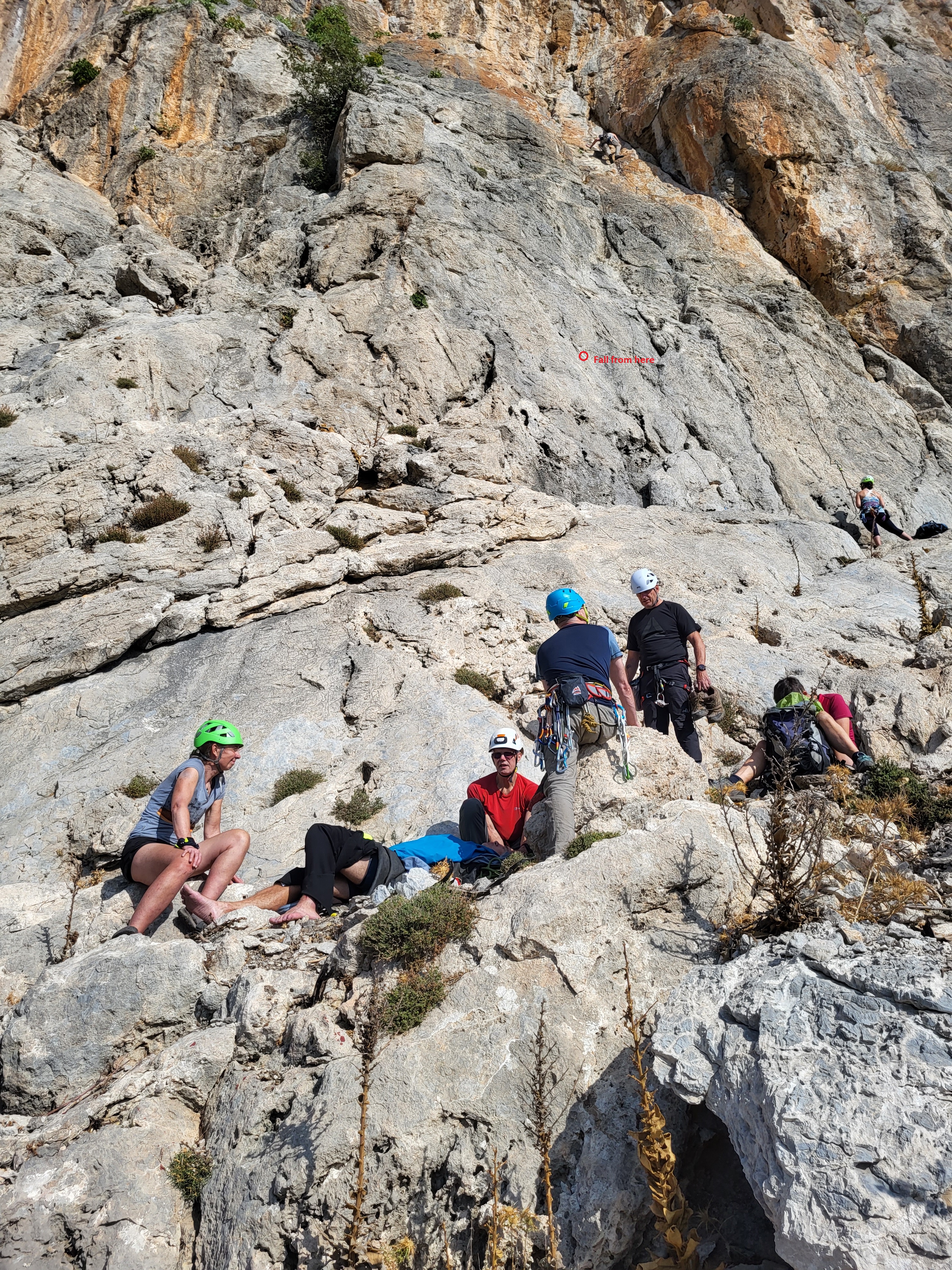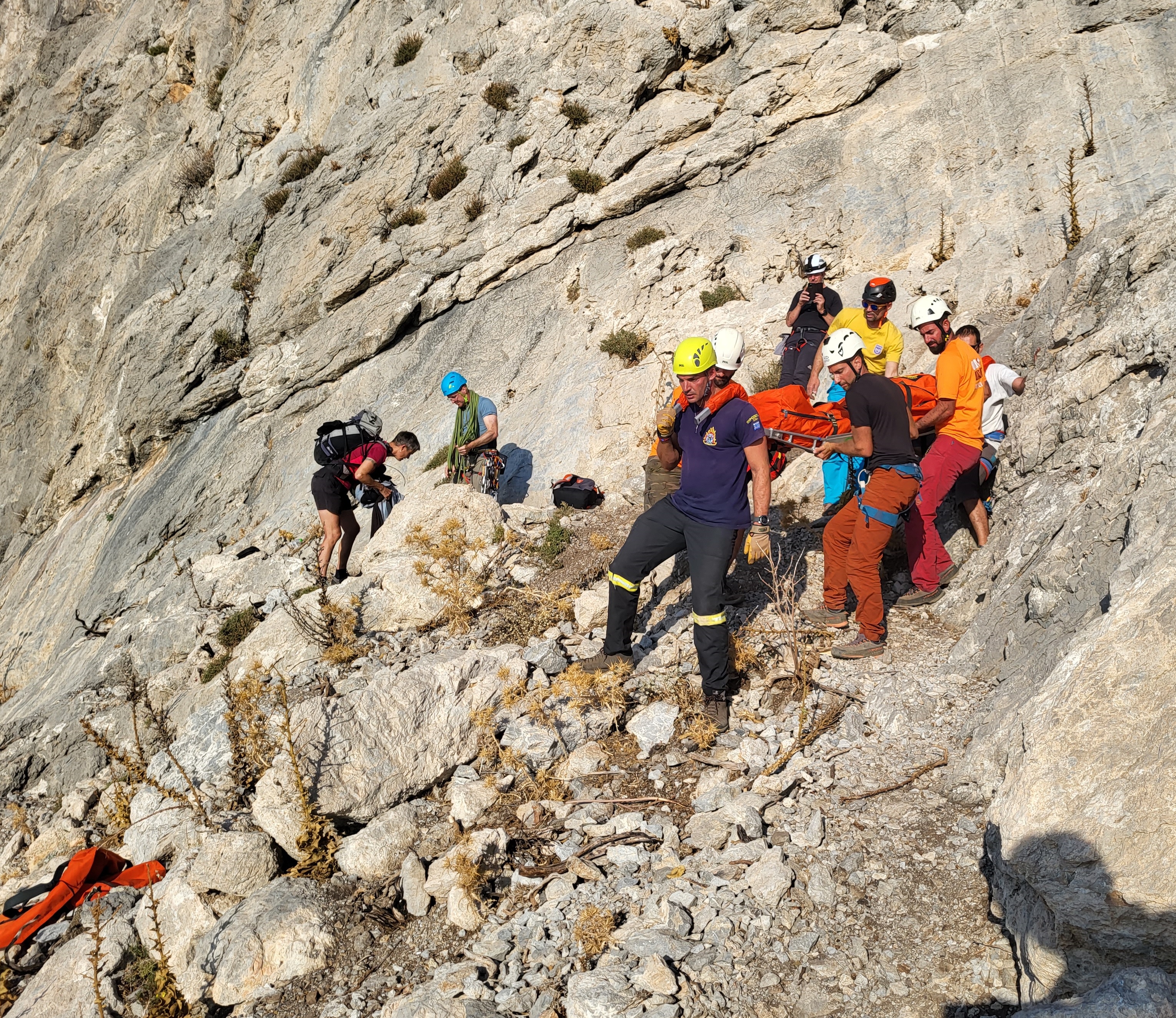Loading...
Activity
Sport rock climbing
When
Descending
Injury
Serious injury requiring medical treatment
Incident
We were on day 5 of a 10-day sport climbing holiday on Kalymnos. This was our fifth visit there in 15 years – so both a familiar place to climb and style of climbing.
The routes are all sport, mainly single pitch up to 40m, often dramatically positioned and incredibly well bolted with little run-out between bolts and well-equipped anchors. It’s become so popular now that the local climbers and guides, who equip and maintain the routes, encourage all climbers to help reduce wear on the anchor clips by only top roping and lowering on your own carabiners, with the last person then only abseiling on the fixed gear, rather than lowering. It's evident why this is needed as even relatively new stainless anchor clips can have significant visible thinning from the combination of a dusty, gritty environment and too much lowering. We had been adhering to this guidance all week, so had both abseiled down multiple times already.
On our sixth route of the day, a 30m classic 3* F5b+ slab, Ginette, Clare led first, added a screwgate crab to the belay on which I lowered her while she cleaned the draws so I could then lead. The ‘ground’ was actually a 1m or so wide ledge, itself 3-4m above the rough, rocky, steep hillside we had walked up to reach the crag. Back down at the ledge Clare told me to be aware of what she thought might be a hornet’s nest close to the top anchors. She had seen a couple emerging from a pocket which she thankfully hadn’t put her hand in. We had on a couple of previous days been buzzed by rather agitated hornets at the bottom of climbs on other crags, so this sounded a bit worrying.
I comfortably cruised up the route, which was much easier than my previous two leads. Nearing the anchors I looked carefully for the hornet hole and noticed a few in the air which freaked me out a bit. ‘Be quick but careful’ I thought to myself. I quickly made myself safe to the anchors and without untying clipped my end of rope back into the fixed gear before removing our screwgate. I then pulled up plenty of rope from the ground through the anchors letting the growing loop to my end become sufficiently large enough to hang down the route perhaps 10m or so. Then I untied, dropped my end and pulled through more rope. The falling rope below however was snagged on ledges or vegetation, and I couldn’t free the end to see that it reached the ground. Still thinking about hornets, lunch and the water I would drink at the bottom, I continued to pull up more rope from the ground. Our rope was 80m long, so comfortably long enough to abseil the 30m route on the two ends. I pulled up a few more metres for good measure but didn’t think I’d reached the halfway markers yet.
Carefully going through my ABC check and using a prussik safety brake below my belay device, I set off down, freeing the snagged rope end and seeing it now reached the ledge. As I cleaned the draws off and using the prussik ‘dead-man’s handle’ I even stopped to take a couple of pics of a friend as he led up the adjacent line with the stunning backdrop of Telendos Island beyond. It was 2:27pm, sunny and warm, but breezy enough not to have yet retreated to the beach.
Getting nearer to the ledge, I realised I had somehow missed a couple of quickdraws which were now just above but slightly behind me. They weren’t though still clipped to the rope, which puzzled me. (It should have been a big red flag!) I called down to Clare, now perhaps 5m below me, and asked why the draws didn’t have the rope through them. She answered that maybe they flicked out when I pulled the ropes through. Still pondering this I monkeyed back up a metre or so to the higher of the two, removed it, got back on the abseil device and went to take out the last runner.
Suddenly I had an unknotted rope end in my left hand above my belay device and above my head, at the same time I apparently quite calmly said to Clare in disbelief ‘I’m off the end of rope’. In an instant I was hurtling downwards, hitting the belay ledge 4-5m below sideways on, bouncing off and hitting the hillside another 3-4m below and apparently cartwheeling on down the rough steeply sloping ground, before finally coming to a halt after a further 10m wrapped around rocks and scrubby vegetation. I remember each crunching impact and being surprised I hadn’t stopped on the first two. When I did stop on the third it felt a much bigger and messier blow, but I remember thinking to myself ‘that wasn’t good but I’m OK’ and started to try to stand up. I was immediately aware of Clare’s screaming voice racing towards me. I was facing the sloping ground lying on my left side, but when I tried to push myself up my left arm was useless, and my left foot gained no traction. I remember telling Clare not to hug me and that I was fine, but she was of course trying to stop me moving in case of spinal injury. In the next instant a calming voice said to Clare ‘I’m Richard, I’m a doctor and our group are part of the Dartmoor Mountain Rescue team’. What incredibly good fortune!
While waiting for the local mountain rescue team, I had already realised that, whereas it would normally be knotted onto a loop of our rope bag, I had failed to re-tie the non-climbing end of the rope back on after running it through the previous evening. The free hanging last two quickdraws were there because I had simply pulled up way too much rope from the ground and there was no knot to stop this happening. At that point I was essentially only reaching them by virtue of rope stretch. So, it was the non-climbing rope end I came off. That simple knot would have prevented me coming off the end and, even before I started abseiling, alerted me and/or those on the ground as the rope bag was pulled up in the air. On every other day of the holiday and the 30 or so routes we had climbed this knot had been in place. I should also of course much more fundamentally looked down as I abseiled to check that both my ropes were on the ground, such that the 'back-stop' knot was never even tested.
Lessons
Check every component of the system before commencing any abseil. ABCDE - Anchors, Belay device, Carabiner locked, D buckle of harness tight, Everything else.
Always knot the rope ends, either together or individually, a metre or so up from the ends. Check rope ends have reached the ground and ask others on the ground to confirm if you can't see. I in doubt find the middle markers and start again. Keep checking as you descend.
Causes
Abseil or rappel failure or error
Anonymous?
No
Reported By
Participant
Wearing Helmets?
Yes
Rescue Services Involved?
Kalymnos Mountain Rescue, Kalymnos ambulance service.


Author
Guy Channer
3 November 2022 at 07:19:23
For more advice and guidance on good practices visit BMC skills
All reports are self-submitted and have not been edited by the BMC in any way, so please keep an open mind regarding the lessons and causes of each incident or near-miss.
If you have a concern regarding this report please contact us at incidentreports@thebmc.co.uk